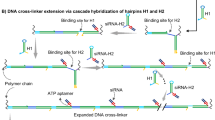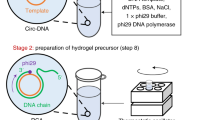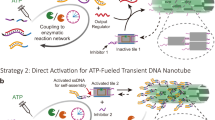Abstract
Artificial DNA nanostructures, with their sequence programmability, precise molecular recognition and tunable stimuli responsiveness, bridge material chemistry and biomedicine. Here we detail the design and construction of hybridization chain reaction (HCR)-based DNA nanoframeworks, a class of DNA nanostructures with programmable sequences and customizable functions. HCR is an efficient, enzyme-free amplification strategy that isothermally produces nicked double-stranded DNA with periodically repeated modules via the assembly of two DNA hairpins, triggered by a DNA initiator. In contrast to other available assembly methods for the synthesis of DNA nanostructures, such as tile-mediated assembly, DNA origami and rolling circle amplification, the HCR method offers improved stability and efficiency under mild conditions, without reliance on enzymatic activity. The procedure uses radical polymerization to integrate DNA initiator into nanoframeworks, with overhangs complementary to functional sequences — termed linkers —which are amplified and incorporated through HCR. The linkers enable the incorporation of functional nucleic acid sequences. The HCR-based DNA nanoframeworks facilitate the loading capability of the delivered molecules, showing notable therapeutic efficacy and biosensing sensitivity. Preparation time for HCR-based DNA nanoframeworks ranges from 30 h to 45 h, depending on the payload.
Key points
-
The procedure covers the design and preparation of the nanoframeworks, the loading of functional nucleic acid sequences via hybridization chain reaction and their characterization, followed by their evaluation as therapeutics and as biosensors.
-
Th procedure uses an enzyme-free isothermal amplification-based self-assembly approach with mild reaction conditions and high amplification efficiency, which is easy to implement.
This is a preview of subscription content, access via your institution
Access options
Access Nature and 54 other Nature Portfolio journals
Get Nature+, our best-value online-access subscription
$32.99 / 30 days
cancel any time
Subscribe to this journal
Receive 12 print issues and online access
$259.00 per year
only $21.58 per issue
Buy this article
- Purchase on SpringerLink
- Instant access to full article PDF
Prices may be subject to local taxes which are calculated during checkout








Similar content being viewed by others
Data availability
The main data supporting the examples of this protocol are available in the supporting primary research papers (https://doi.org/10.1038/s41467-021-21442-7, https://doi.org/10.1126/sciadv.adi3602, https://doi.org/10.1002/adma.202300823, https://doi.org/10.1002/anie.202207770, https://doi.org/10.1002/adfm.202312880). Additional data are available from the corresponding author upon reasonable request.
References
Seeman, N. C. Nucleic acid junctions and lattices. J. Theor. Biol. 99, 237–247 (1982).
Kallenbach, N. R., Ma, R.-I. & Seeman, N. C. An immobile nucleic acid junction constructed from oligonucleotides. Nature 305, 829–831 (1983).
Madsen, M. & Gothelf, K. V. Chemistries for DNA nanotechnology. Chem. Rev. 119, 6384–6458 (2019).
Li, Q. et al. A poly(thymine)-melamine duplex for the assembly of DNA nanomaterials. Nat. Mater. 19, 1012–1018 (2020).
Lu, C. H. & Willner, I. Stimuli-responsive DNA-functionalized nano-/microcontainers for switchable and controlled release. Angew. Chem. Int. Ed. 54, 12212–12235 (2015).
Seeman, N. C. & Sleiman, H. F. DNA nanotechnology. Nat. Rev. Mater. 3, 17068 (2017).
Kwak, M. & Herrmann, A. Nucleic acid amphiphiles: synthesis and self-assembled nanostructures. Chem. Soc. Rev. 40, 5745–5755 (2011).
Rossi-Gendron, C. et al. Isothermal self-assembly of multicomponent and evolutive DNA nanostructures. Nat. Nanotechnol. 18, 1311–1318 (2023).
Zhang, F., Nangreave, J., Liu, Y. & Yan, H. Structural DNA nanotechnology: state of the art and future perspective. J. Am. Chem. Soc. 136, 11198–11211 (2014).
Yao, C. et al. A DNA nanocomplex containing cascade DNAzymes and promoter-like Zn-Mn-Ferrite for combined gene/chemo-dynamic therapy. Angew. Chem. Int. Ed. 61, e202113619 (2022).
Guo, X. et al. Gene circuit compartment on nanointerface facilitatating cascade gene expression. J. Am. Chem. Soc. 141, 19171–19177 (2019).
Simmel, F. C., Yurke, B. & Singh, H. R. Principles and applications of nucleic acid strand displacement reactions. Chem. Rev. 119, 6326–6369 (2019).
Li, F. et al. Spatiotemporally programmable cascade hybridization of hairpin DNA in polymeric nanoframework for precise siRNA delivery. Nat. Commun. 12, 1138 (2021).
Bi, S., Yue, S. & Zhang, S. Hybridization chain reaction: a versatile molecular tool for biosensing, bioimaging, and biomedicine. Chem. Soc. Rev. 46, 4281–4298 (2017).
Chen, Y. J., Groves, B., Muscat, R. A. & Seelig, G. DNA nanotechnology from the test tube to the cell. Nat. Nanotechnol. 10, 748–760 (2015).
Belmont, P., Constant, J. F. & Demeunynck, M. Nucleic acid conformation diversity: from structure to function and regulation. Chem. Soc. Rev. 30, 70–81 (2001).
Chagri, S., Ng, D. Y. W. & Weil, T. Designing bioresponsive nanomaterials for intracellular self-assembly. Nat. Rev. Chem. 6, 320–338 (2022).
Keller, A. & Linko, V. Challenges and perspectives of DNA nanostructures in biomedicine. Angew. Chem. Int. Ed. 59, 15818–15833 (2020).
Li, F. et al. Supramolecular self-assembled DNA nanosystem for synergistic chemical and gene regulations on cancer cells. Angew. Chem. Int. Ed. 60, 25557–25566 (2021).
Lv, Z. et al. A smart DNA nanoassembly containing multivalent aptamers enables controlled delivery of CRISPR–Cas9 for cancer immunotherapy. Adv. Funct. Mater. 34, 2311069 (2023).
Song, N. et al. Cascade dynamic assembly/disassembly of DNA nanoframework enabling the controlled delivery of CRISPR–Cas9 system. Sci. Adv. 9, eadi3602 (2023).
Lv, Z. et al. A smart DNA-based nanosystem containing ribosome-regulating siRNA for enhanced mRNA transfection. Adv. Mater. 35, e2300823 (2023).
Yuan, M. et al. Controlled sequential assembly of DNA nanoparticles inside cells enabling mitochondrial interference. Adv. Funct. Mater. 34, 2312880 (2023).
Dong, Y. et al. Lysosome interference enabled by proton-driven dynamic assembly of DNA nanoframeworks inside cells. Angew. Chem. Int. Ed. 61, e202207770 (2022).
Whitehead, K. A., Langer, R. & Anderson, D. G. Knocking down barriers: advances in siRNA delivery. Nat. Rev. Drug Discov. 8, 129–138 (2009).
Winkle, M., El-Daly, S. M., Fabbri, M. & Calin, G. A. Noncoding RNA therapeutics-challenges and potential solutions. Nat. Rev. Drug Discov. 20, 629–651 (2021).
Doudna, J. A. & Charpentier, E. The new frontier of genome engineering with CRISPR–Cas9. Science 346, 1258096 (2014).
Jinek, M. et al. A programmable dual-RNA-guided DNA endonuclease in adaptive bacterial immunity. Science 337, 816–821 (2012).
He, L. et al. mRNA-initiated, three-dimensional DNA amplifier able to function inside living cells. J. Am. Chem. Soc. 140, 258–263 (2017).
Hou, X., Zaks, T., Langer, R. & Dong, Y. Lipid nanoparticles for mRNA delivery. Nat. Rev. Mater. 6, 1078–1094 (2021).
Huang, X. et al. The landscape of mRNA nanomedicine. Nat. Med. 28, 2273–2287 (2022).
Hu, Q., Li, H., Wang, L., Gu, H. & Fan, C. DNA nanotechnology-enabled drug delivery systems. Chem. Rev. 119, 6459–6506 (2019).
Huang, P., Deng, H., Zhou, Y. & Chen, X. The roles of polymers in mRNA delivery. Matter 5, 1670–1699 (2022).
Leung, K., Chakraborty, K., Saminathan, A. & Krishnan, Y. A DNA nanomachine chemically resolves lysosomes in live cells. Nat. Nanotechnol. 14, 176–183 (2019).
Xiao, M. et al. Rationally engineered nucleic acid architectures for biosensing applications. Chem. Rev. 119, 11631–11717 (2019).
Guo, Y. et al. Telomerase-mediated self-assembly of DNA network in cancer cells enabling mitochondrial interference. J. Am. Chem. Soc. 145, 23859–23873 (2023).
Li, F. et al. Dynamic assembly of DNA nanostructures in living cells for mitochondrial interference. J. Am. Chem. Soc. 144, 4667–4677 (2022).
Zhao, J., Li, Z., Shao, Y., Hu, W. & Li, L. Spatially selective imaging of mitochondrial microRNAs via optically programmable strand displacement reactions. Angew. Chem. Int. Ed. 60, 17937–17941 (2021).
Fu, J., Liu, M., Liu, Y. & Yan, H. Spatially-interactive biomolecular networks organized by nucleic acid nanostructures. Acc. Chem. Res. 45, 1215–1226 (2012).
Liu, J. et al. A tailored DNA nanoplatform for synergistic RNAi-/chemotherapy of multidrug-resistant tumors. Angew. Chem. Int. Ed. 57, 15486–15490 (2018).
Mao, D. et al. An intelligent DNA nanoreactor for easy-to-read in vivo tumor imaging and precise therapy. Angew. Chem. Int. Ed. 63, e202311309 (2024).
Dong, Y. et al. DNA functional materials assembled from branched DNA: design, synthesis, and applications. Chem. Rev. 120, 9420–9481 (2020).
Dey, S. et al. DNA origami. Nat. Rev. Methods Primers 1, 13 (2021).
Ali, M. M. et al. Rolling circle amplification: a versatile tool for chemical biology, materials science and medicine. Chem. Soc. Rev. 43, 3324–3341 (2014).
Wang, Y., Nguyen, K., Spitale, R. C. & Chaput, J. C. A biologically stable DNAzyme that efficiently silences gene expression in cells. Nat. Chem. 13, 319–326 (2021).
Faiad, S. et al. Impact of the core chemistry of self‐assembled spherical nucleic acids on their in vitro fate. Angew. Chem. Int. Ed. 62, e202315768 (2023).
Qin, B. et al. Enzymatic synthesis of TNA protects DNA nanostructures. Angew. Chem. Int. Ed. 63, e202317334 (2024).
Tang, J. et al. A DNA/poly-(l-lysine) hydrogel with long shelf-time for 3D cell culture. Small Methods 8, 2301236 (2024).
Dirks, R. M. & Pierce, N. A. Triggered amplification by hybridization chain reaction. Proc. Natl Acad. Sci. USA 101, 15275–15278 (2004).
Venkataraman, S., Dirks, R. M., Rothemund, P. W. K., Winfree, E. & Pierce, N. A. An autonomous polymerization motor powered by DNA hybridization. Nat. Nanotechnol. 2, 490–494 (2007).
Lv, Z. et al. Hybridization chain reaction-based DNA nanomaterials for biosensing, bioimaging and therapeutics. Chin. Chem. Lett. 35, 108601 (2024).
Weng, Y. et al. The challenge and prospect of mRNA therapeutics landscape. Biotechnol. Adv. 40, 107534 (2020).
Wan, T. et al. Material solutions for delivery of CRISPR/Cas-based genome editing tools: current status and future outlook. Mater. Today 26, 40–66 (2019).
Guo, Y. et al. Evaluation of pharmacokinetics, immunogenicity, and immunotoxicity of DNA tetrahedral and DNA polymeric nanostructures. Small Methods, 2401007 (2024).
Acknowledgements
This work was supported by National Natural Science Foundation of China (grant nos. 22225505, 22322407 and 22174097). D.Y. thanks Fudan University Ruiqing Education Funding.
Author information
Authors and Affiliations
Contributions
D.Y. and C.Y. supervised the projects. Z.L. and P.L. designed and conducted the experiments. Z.L., P.L. and M.L analyzed the data. Z.L., P.L., M.L, C.Y. and D.Y. wrote the manuscript.
Corresponding authors
Ethics declarations
Competing interests
The authors declare no competing interests.
Peer review
Peer review information
Nature Protocols thanks Jong Bum Lee, Veikko Linko, Chengde Mao, Simona Ranallo and Olavi Reinsalu for their contribution to the peer review of this work.
Additional information
Publisher’s note Springer Nature remains neutral with regard to jurisdictional claims in published maps and institutional affiliations.
Key references
Li, F. et al. Nat. Commun. 12, 1138 (2021): https://doi.org/10.1038/s41467-021-21442-7
Song, N. et al. Sci. Adv. 9, eadi3602 (2023): https://doi.org/10.1126/sciadv.adi3602
Lv, Z. et al. Adv. Mater. 35, e2300823 (2023): https://doi.org/10.1002/adma.202300823
Dong, Y. et al. Angew. Chem. Int. Ed. 61, e202207770 (2022): https://doi.org/10.1002/anie.202207770
Yuan, M. et al. Adv. Funct. Mater. 34, 2312880 (2023): https://doi.org/10.1002/adfm.202312880
Rights and permissions
Springer Nature or its licensor (e.g. a society or other partner) holds exclusive rights to this article under a publishing agreement with the author(s) or other rightsholder(s); author self-archiving of the accepted manuscript version of this article is solely governed by the terms of such publishing agreement and applicable law.
About this article
Cite this article
Lv, Z., Li, P., Liu, M. et al. Hybridization chain reaction-based DNA nanoframeworks for biosensing and therapeutic applications. Nat Protoc (2025). https://doi.org/10.1038/s41596-025-01183-3
Received:
Accepted:
Published:
DOI: https://doi.org/10.1038/s41596-025-01183-3
This article is cited by
-
Advances in methods for rapid detection of Staphylococcus aureus and methicillin-resistant S. aureus
Analytical Sciences (2025)



